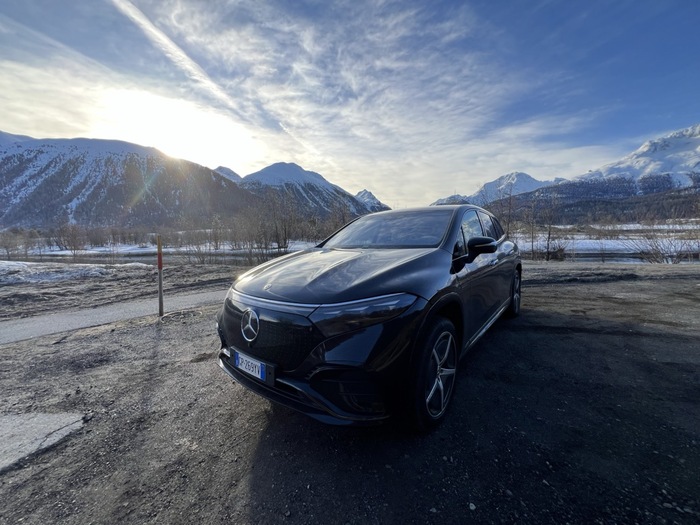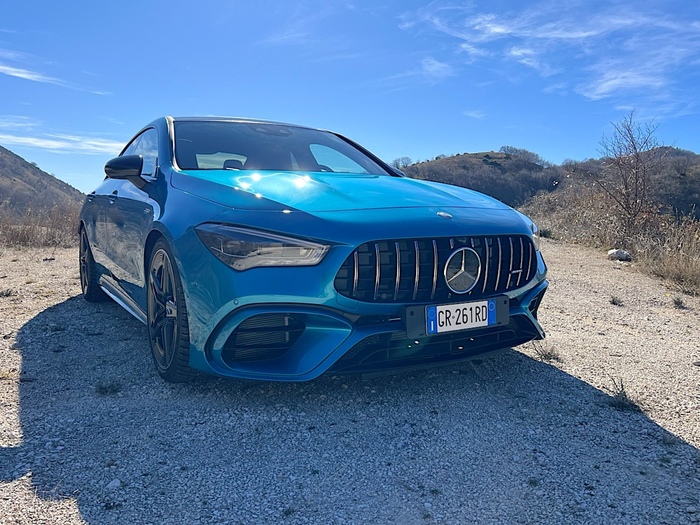Combination comparison: Mercedes CLA against Hyundai i30 – is the difference worth 14,000 euros?
Created: 2022-01-24Updated: 2022-01-24 15:27
By: Rudolf Boegel
Star cruiser CLA Shooting Brake.
An elegant car.
Can it hold its own against the Hyundai il30 station wagon?
©Mercedes
Two cars, two worlds.
Can the Hyundai i30 station wagon outstrip the Mercedes CLA Shooting Brake, which is around 14,000 euros more expensive.
We tested both combos.
The Shooting Brake from Mercedes shines with a star, chic and charm.
The i30 station wagon offers more space and a lower price.
Which of the two compact station wagons has the edge in the end?
Even if the whole world is talking about SUVs*, nothing beats a
station wagon
if you have to transport a lot and often. Either as a craftsman or as a house builder, as a family dad who has to store the skittles as well as the child, or as a family mum who empties the shelves at the discounter week after week for her hungry pack. If you don't want to go all out when it comes to station wagons with a VW Passat Variant, Skoda Octavia or Audi A 4 Avant, you already have a good selection of
compact cars
in a class below. In this test we pit two cars from two very different worlds against each other. Here the elegant
Mercedes CLA Shooting Brake
from Stuttgart - there the
Hyundai i30 station wagon
from South Korea.
The two separate not only the whole Eurasian continent, but also almost 14,000 euros in the purchase price.
Is that justified?
A test in five disciplines.
Home cooking in appearance.
The Hyundai i30 disappears in the crowd with its rather conservative design.
©Hyundai
Read more current driving reports here.
1:0 for Mercedes in design
Even if taste is in the eye of the beholder and you are familiar with the topic
Design can argue excellently:
The first point in the first discipline "Appearance" clearly goes to the car manufacturers with the star
. If the
CLA
is already an elegant car as a limousine that is suitable for any parquet, the elongated
Shooting Brake
becomes a real shooting star in terms of design. A car for gourmets, because you eat with your eyes. The Korea-Kombi, on the other hand, stands for real home cooking. At 4.59 meters, it is also a whole ten centimeters shorter than the fine competition, which means that the
coupé line
cannot swing quite as elegantly as with the Mercedes.
Mercedes
also shows more character
in the front and rear sections .
When you look, the Hyundai is simply left behind.
Air vents reminiscent of an engine and a continuous HD display - this is what the CLA looks like inside.
©Mercedes
Also read
: BMW iX3 driving test: How good is the electric car compared to the conventional X3?
Sharing of points between i30 and CLA in the interior
Which unfortunately also
applies to the
interior
. The large
chrome air vents in the CLA
are reminiscent of small aircraft engines and give the
Mercedes
an extravagance that is rarely found in this class. A class difference is also
noticeable in the
displays
. The two Mercedes
HD screens
are framed by a glass frame and look futuristic. The
graphics
also look classy and snazzy, while all of that looks
rather conventional on the
il30
. Two displays strictly separated, with infotainment everything works with a simple tile look. But the
Hyundai scores
when serving.
Everything is logical here, the tedious search in submenus is almost completely eliminated.
At Mercedes, on the other hand, you have a hodgepodge of controls.
On the steering wheel, on the display, on the touchpad, on the center console - something can be switched on, adjusted, pressed or swiped almost anywhere.
To be honest, that was too much for us during the test drives.
One wonders why the legislator brutally punishes a quick glance at the mobile phone, but you can play around with the vehicle display for minutes to find the right ambient light.
When it comes to the interior, the CLA and il30 share the points.
A clear 1:1.
Mercedes clears the design, Hyundai counters with the usability.
The instrumentation in the Hyundai il30 is clear and extremely practical.
Hardly any frills, but utility.
©Hyundai
Read here
: SUV comparison: Is the Ford Puma enough or does it have to be a Kuga for 9,000 euros more?
The truth is on the pitch, Hyundai advantage
Let's come to the space conditions. There is plenty of space for the passengers on both sides, especially in the front, of course. But the
Hyundai
is not only shorter, but also a notch narrower, but a little higher than the Mercedes. That may be the reason why you might feel a little more comfortable in the
Daimler
as a driver and passenger. When you get in the back of the CLA you have to duck your head because of the low coupé line - and that's from a body length of 1.70 m. This is a little easier with the Hyundai because it is higher. In both cases, however, you get a little apprehensive when you imagine a longer tour. But that is due to the type of vehicle, after all we are in the
compact segment
.
No model has a clear advantage here.
When it comes to trunk volume, the game is different.
Here the i30 comes up with almost mid-range values.
602 to 1,650 liters (with the rear seat folded down completely) fit in here.
The Mercedes has 495 and 1,360 liters respectively.
Up to eleven crates fit into the Mercedes.
However, the loading sill is higher than in the Hyundai i30.
© Daimler AG - Global Communication
Also read:
The new Kia Sportage: you should know about the compact SUV
Easier to load the Hyundai i30
Nevertheless, the ADAC found a factual tie in tests.
The experts measured exactly eleven beverage crates in both station wagons.
So why the big difference?
Apparently, the colleagues from the Far East count every cubic centimeter of storage space that is available in the loading platform or in the side panels.
Still, the
point for space
goes
to Hyundai
.
According to ADAC measurements, the loading sill is only 63 centimeters high here, while the Mercedes is 75 centimeters high.
And it's also impractical on the car with the star, because inside the vehicle it sinks 22 centimeters down to the loading floor, while it's flat on the Hyundai.
Which allows for less stressful and easier loading.
Point victory for the i30.
According to the ADAC, up to 11 beverage crates also fit in the Hyundai.
The loading sill is lower and just merges into the floor.
©Hyundai
The diesel-off puts Hyundai behind
When it comes to engines, Daimler has slight advantages
, at least when you look at
diesel aggregates
stands. Hyundai removed them at least from the i30 in a night and fog action, only slightly electrified petrol engines are available. We still had the old 1.6-liter turbo diesel and were actually quite satisfied with its torque and fuel consumption. The engine was approved for six liters, but – as I said – it is no longer available, at least on the new car market. With the CLA we had the pleasure of the 190 hp turbo diesel. It accelerates from 0 to 100 in a brisk 7.2 seconds with the robust torque of 400 Newton meters (Nm), which starts at 1600 rpm. The fun with the gas pedal is also noticeable in the wallet. The compression-ignition engine consumed just under seven liters during the test drives. Nevertheless, another point for the Mercedes.
The Mercedes CLA is ten centimeters longer than its competitor i30 from Hyundai.
©Mercedes
Also interesting:
practical test V60 Cross Country: What can the nature boy from Volvo do?
Wafer-thin victory for Mercedes - because of!
At 3:2, the comparison is extremely narrow in favor of the CLA Shooting Brake.
A razor-thin victory, but in the 93rd minute in injury time it still ended in a draw.
That is when it comes to the price.
It's naturally hot at Mercedes.
You pay around 14,000 euros more for the premium model.
Specifications Mercedes CLA 220d Shooting Brake
Engine: four-cylinder turbo diesel
Displacement: 1,950 cc
Power: 140 kW (190 hp)
Torque: 400 Nm at 1,600 rpm
Drive: Eight-speed dual-clutch transmission, front
0-100km/h: 7.2s
Top speed: 221 km/h
Standard consumption: 5.0 - 5.6 l (test consumption 6.9 l)
CO2 emissions: 131 - 147 g/km
Length/width/height: 4.69/1.83/1.45 m
Curb weight/allowance: 1,585/555 kg
Towing capacity (used): 1,600 kg
Trunk: 495 - 1,360 l
Price from 43,425 euros (entry-level model CLA 180 34.319)
Technical data Hyundai i30 station wagon 1.5 T-GDI, 48V, hybrid*, trend
Engine: four-cylinder turbo petrol engine (mild hybrid)
Displacement: 1482 cc
Power: 118 kW (160 hp)
Torque: 253 Nm at 1500 rpm
Drive: DCT transmission, front
0-100km/h: 8.6s
Top speed: 210 km/h
Standard consumption: 6.3 l (ADAC test: 7.1 l)
CO2 emissions: 142 g/km
Length/width/height: 4.59/1.80/1.47 m
Curb weight/allowance: 1,376/504 kg
Towing capacity (used): 1,410 kg
Trunk: 602 – 1,650 l
Price from 29,590 euros (entry model 19,990)
*The old 1.6 CRDI engine, which is no longer available in the I30, was also tested.
The four-cylinder turbo diesel had 136 hp, a torque of 320 Nm and consumed 5.4 liters of diesel (according to the technical data), in the test he approved half a liter more.
Rudolf Bögel *tz.de is an offer from IPPEN.MEDIA.







